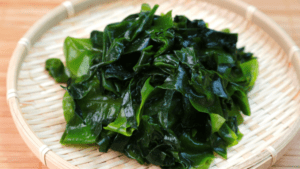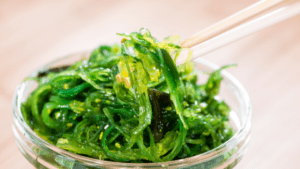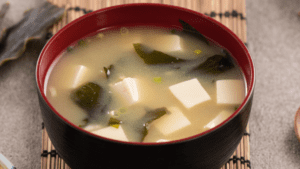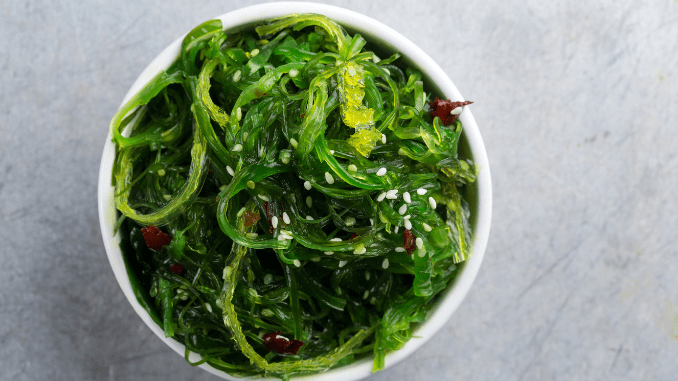Know in one minute about Seaweed salad
|
Introduction
What is a seaweed salad and how is it nutritious?
There are several health benefits of seaweed salad. Seaweed, basically, is a true superfood and is considered the world’s healthiest food. They are marine organisms that belong to a class of algae species. These plants ensure oxygen production cleanse their surrounding water, and have an arrangement that ensures the basis of growth in the other marine species.
Hence, Seaweeds, a marine form of algae, are found in all the earth’s oceans, in all climate zones.
Seaweeds contain large amounts of vitally important protein, and antioxidants are the body’s primary building blocks for muscle, skin, hair, bone, etc. This salad is fat-free, which is why it is increasingly described as the perfect ‘heart-healthy’ food.
Demand for this salad
Seaweeds are extremely nutrient-rich, having a mineral content ten times greater than that found in land plants.
A study suggests that seaweed has twelve times more calcium than milk and more protein than eggs (1).
The speciality of this salad

- Seaweeds are highly nutritious and a superfood ingredient in our meals. It includes many varieties of seaweed like wakame, kemp, spirulina, etc.
- Wakame is mostly used for salads that belong to the seaweed species.
- Seaweed salad contains a great source of omega-3 fatty acids that play a key role in suppressing inflammation in the body.
Nutrient Profiling Of Seaweed Salad
100 gm of seaweed salad provides the following:
| Nutritional | Composition |
| Calories | 70gm |
| Protein | 1gm |
| Carbohydrates | 11gm |
| Fiber | 5gm |
| Sugar | 6gm |
| Fat | 2.5gm |
| Sodium | 36% |
| Folate | 5% of Reference Daily Intake |
- They are also used as a traditional therapy for treating goiter and thyroid conditions because of high-iodine concentrations.
- Consumption of this salad also nourishes the skin and prevents hair loss.
- This salad is low in calories and helps in promoting good cholesterol levels in the body.
Health benefits of seaweed salad
1. Seaweed As Immune Booster
The presence of Vitamin A and B Vitamins increases the immunity of the body and encourages it to fight against diseases (2).
2. Reducing Cancer Symptoms
It plays a key role in reducing thyroid cancers in patients as the reference daily intake of iodine is high as compared to other nutrients. It works wonders in treating goiter (3).
3. Maintains Healthy Weight
Seaweed is also used in a range of weight-loss products. It can be claimed that it is a natural appetite suppressant and increases the body’s metabolism (4).
4. Good Digestion
Seaweed contains a high level of dietary fiber that aids in digestion and thus helps in regulating biological processes in the human body. It cleanses the body by removing the toxic elements from the body (5).
5. Healthy for heart
Seaweed contains large amounts of vitally important proteins that are purely fat-free and hence can be described as the perfect “Heart Healthy Food” (6).
Precautions and side effects of seaweed
Seaweed salad is a well-known dish in Japanese and Korean cuisines, but there are some precautions that need to be taken while consuming it.
1. High Iodine Content
Seaweed possesses high iodine content that causes side effects in people with thyroid conditions or people with high medications.
It is necessary to consult with your doctor before consuming seaweed if you have any existing medical conditions.
2. High Metal Intoxication
Variants of seaweed contain high levels of heavy metals intoxication like lead and mercury.
Hence, one must buy from reliable sources and check the labels for information regarding the sourcing of the products. Nutritional labeling must be checked further to ensure the nutritional values.
3. Toxins
Seaweed has certain toxins that are declared unsafe for consumption. Hence, proper research needs to be done before purchasing from the suppliers for enhanced safety.
4. Gastrointestinal effect
Seaweeds can have adverse effects on the intestine, if consumed without proper knowledge can be dangerous for the intestine and cause stomach upset. They can cause gastrointestinal disorders such as Gracilaria and Caulerpa (7).
5. Skin Allergy
Excessive consumption of seaweeds causes yellowing of the skin and also results in thyroid-stimulating hormone.
Recipes of Seaweed salad

1. Winged Kelp also known as edible wings.
PREPARATION
- Soak the kelp/seaweed in cold water for 15-30 minutes.
- Boil until tender, 5-15 minutes depending on the size.
Winged kelp has a mild taste profile which makes it ideal with many other ingredients without undermining their original flavor.
- It can be blanched or steamed and used in salads, stews, wok dishes, and soups.
- It tastes especially delicious marinated in lemon and soy sauce as an accompaniment to fish and other seafood, light meat, and vegetables.
Special tip: Take care that you do not boil the winged kelp for too long.
2. Kelp Japanese Soup

Seaweed Dukkah
Preparation time: 20 minutes
Ingredients
Hazelnuts: 10 g
Sesame seeds: 30 g
Dried seaweed: 10 g
Dried laver: 5 g
Coriander: 5 g
Cumin: 5 g
Salt flakes: 5 g
Black pepper: 5 g
Method
- Preheat the oven to 150°C
- Place all the ingredients on a baking sheet and roast for approximately 10 minutes.
- Mix them well and grind the mixture in a mortar.
- Store in an airtight container.
Parsley Pesto
Prepration Time: 15 minutes
Ingredients
3 g dried winged kelp
16 g parsley
Coarsely chopped 16 g walnuts
Coarsely chopped 8 g pecorino (or Parmesan)
Freshly grated 1 tsp lime juice
0.6 g fresh ginger root, peeled and chopped
Chopped 1/2 garlic clove
16 ml olive oil
2 g sea salt and Pepper
Method
Soak the winged kelp for 30 minutes in water, then drain and squeeze out the water. Chop coarsely. Combine all the ingredients to a coarse mixture.
Q&A
What is seaweed salad made of?
Wakame seaweed which belongs to the class of marine algae is specially used in the preparation of seaweed salads. Many varieties of seaweed are also used in other preparations.
Is seaweed salad good or bad for you?
Seaweed salads are extremely beneficial when consumed in a limited quantity and the quality needs to be verified from reliable sources. Excessive consumption can result in intoxication in an individual.
Is it OK to eat seaweed salad everyday?
Yes, but at a limited amount of 5 grams/day. (in the case of dried seaweed)
What is the difference between seaweed and wakame salad?
Wakame seaweed is a type of seaweed but if we talk about wakame salad, it is rather more refreshing and provides a mild sea flavor, when added to different cuisines. Wakame is basically low in calories in comparison to other seaweeds.
